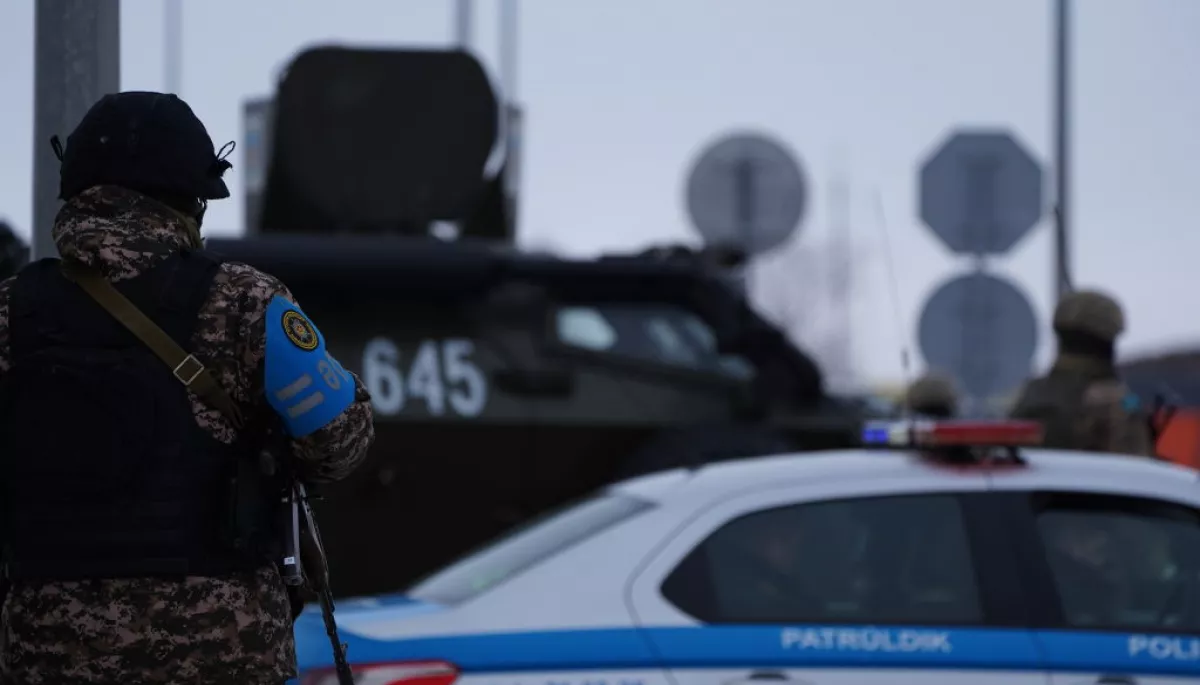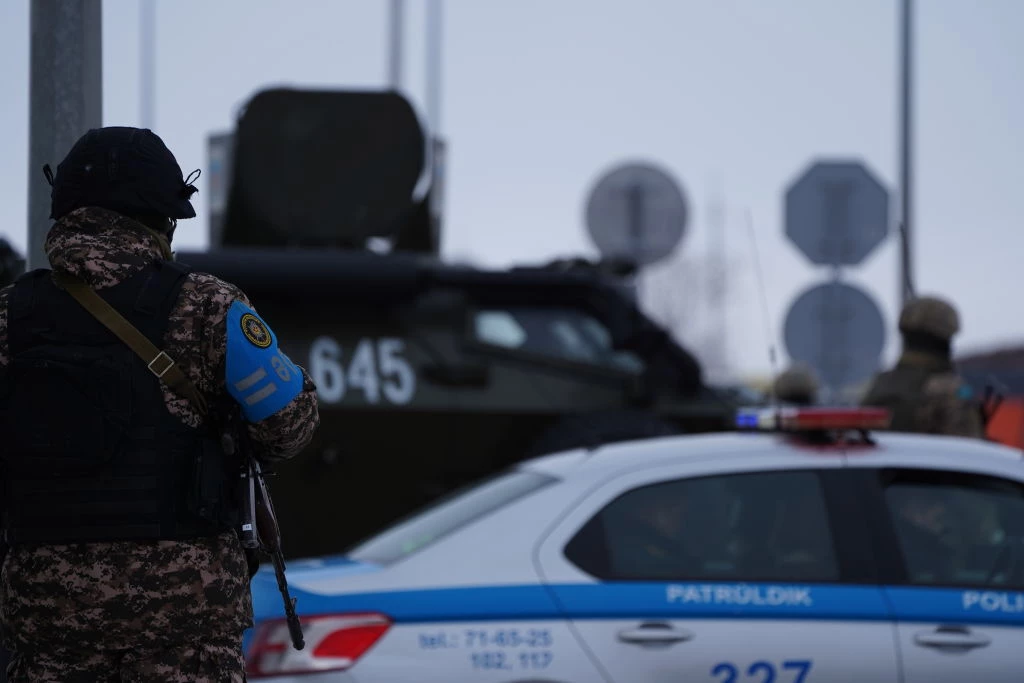
Ukraine's scenario for Kazakhstan or vice versa? Analysis of manipulations in the Ukrainian segment of social networks
Ukraine's scenario for Kazakhstan or vice versa? Analysis of manipulations in the Ukrainian segment of social networks


On January 2nd, 2022, protests erupted in Kazakhstan after fuel price rise. During the week, people rallied in various cities across the country, storming and setting fire to the administration building, demanding lower gas prices. Within three days, the authorities went through the procedures and announced the introduction of state regulation of the price of gasoline and diesel fuel. On the same day, the Kazakh government resigned, and President Kasim-Zhomart Tokayev replaced the country's first leader, Nursultan Nazarbayev, as chairman of Kazakhstan's National Security Committee. However, on the evening of January 5th, Tokayev turned for help to the Collective Security Treaty Organization: a military contingent of Russia, Belarus, Armenia, Tajikistan and Kyrgyzstan arrived in Kazakhstan on January 7th. The military took control over a number of strategic sites in Kazakhstan and suppressed protests within days. Nevertheless, the CSTO announced the end of the operation only on January 19th. According to the Prosecutor General's Office of Kazakhstan, 225 people were killed during the protests (206 civilians and 19 security officers), 4 578 people were injured (according to the authorities the majority of seriously injured, in particular 3 393 people, are ecurity officers). The first week of the year in Kazakhstan filled media headlines, they were even more actively discussed on social networks. For example, in the first 10 days of January in the second segment of telegrams there were more than 15000 posts on the keyword "Kazakhstan", while on Volodymyr Zelensky - only more than four thousand posts.
Using machine learning and artificial intelligence elements, Detector Media analyzed more than 8,000 social media posts to identify pro-Russian rhetoric about the situation in Kazakhstan but in the social networks of Ukraine.
Sources: Ukrainian segment of Facebook (pages, social groups with more than 10,000 subscribers) and Telegram, and the Russian segment of Telegram. By Ukrainian segment, we mean posts of profiles, pages, groups, and channels located in Ukraine or which have indicated their location as in Ukraine. Accordingly, under Russian - those who indicated itself as in Russia.
Monitoring period: January 1-10th, 2022
1. Old techniques in a new context: Ukraine, Belarus, and now Kazakhstan
The discrediting of the protest in Kazakhstan took place according to a long-tested scenario. We can see the cities and countries that are most mentioned in posts about the situation in Kazakhstan, where Ukraine in the leaders, because most often parallels were drawn with the Revolution of Dignity. That is why we see mentions of Crimea and Donbas, because manipulators often reminded that, it was after Maidan that Ukraine lost Crimea and Donbas. The logic of frequent mentions of Belarus is similar.
The West, Britain, the United States of America, and George Soros were immediately blamed for coordinating the protests. Accordingly, as in the situation with protests against election fraud in Belarus, similar accusations were also addressed to Ukraine.
In support of this thesis, information was published about the “Democratic Choice of Kazakhstan” headquarters in Ukraine. The leader of this movement, ex-leader of BTA Bank in Kazakhstan - Mukhtar Ablyazov, has been called the leader of the Kazakh opposition. He was addressed in several critical posts in the Ukrainian segment of social networks, being accused of working for Soros and the United States in collaboration with British intelligence MI-6, ridiculing his statements in the media, etc. Read more about Ablyazov here. A similar situation captured other opposition members who publicly supported the protests in Kazakhstan.
However, the protest was often presented not as a socio-political but as a “clan war.” In particular, with this goal in mind, lists of stores smashed during the protests were published online. These messages emphasized that the possessions of influential groups in Kazakhstan were not affected. They spoke about the confrontation between Kasim-Zhomart Tokayev and Nursultan Nazarbayev in the same context.
Statements by the U.S. Secretary of State Anthony Blinken, who condemned the Kazakh president's order to shoot people, were ridiculed, mainly reminding the Americans of the Capitol’s storming and the Black Lives Matter movement. The messages emphasize that Tokayev allegedly ordered to shoot “people who refused to lay down their arms.” The President of Kazakhstan did not provide such clarifications, and his verbatim quote is: “I gave orders to law enforcement agencies and the army to open fire to defeat without warning. We hear calls from abroad for negotiations to find a peaceful solution to the problem. This is nonsense. What kind of negotiations can we lead with criminals and murderers? We have to deal with armed bandits, both local and foreign, and specifically with bandit-terrorists. Therefore, they must be destroyed. This will be done in the near future.” Instead of this entire message, Russian media only spread the excerpt on those who “refused to lay down arms.”
According to a similar scheme, Clement Bon, the Secretary of State for European Affairs at the French Ministry of Foreign Affairs, gave a statement in which he said that the suppression of protests in Kazakhstan was unacceptable and it reminded him of the “yellow vest” protests.
2. Threatening with the consequences of the “failures” of “color revolutions”
The events in Kazakhstan were compared to the Revolution of Dignity in Ukraine and the protests in Belarus, incessantly hinting that both countries only lost as a result of these events. In particular, they promoted the message that Maidan participants allegedly demanded a reduction in tariffs but instead received a tenfold increase in utility prices. The statements also ridiculed decommunization in Ukraine, predicting denursultanization or de-elbassization in Kazakhstan (“elbasy” means “leader of the nation,” similarly as the first president of Kazakhstan Nursultan Nazarbayev is called). However, this time more hints were used without specifications – “take a look at Ukraine/Belarus,” “it would be a mistake to hope for forces supported by the West,” and so on.
The word “scriptonites” (derived from the pseudonym of the popular Kazakh rapper Scriptonite) was used to identify the protesters. We did not record a mass use of this term in the Ukrainian segment of social networks or the Russian one. However, inventing labels for protesters is not a new tactic: participants of the Revolution of Dignity were often referred to as “maidauns” (майдауни) or “banderas,” (бандерівці) and protesters in Belarus as “competitors” (змагарі) and
“the incredibles” (in Russian: “невероятные”).
3. Independent anonymous Ukrainian Telegram channels
The photo shows a graph with the number of posts and coverage for the keyword “Kazakhstan” in the Ukrainian segment of the Telegram
The photo shows a graph with the number of posts and coverage for the keyword “Kazakhstan” in the Russian segment of the Telegram
In the first ten days of the new year, almost 154,000 posts about Kazakhstan appeared in the Russian segment of the Telegram, with total coverage of 882 million. During this time, 15,000 posts with a coverage of 61.6 million were published in Ukraine. However, this time, the Russian and Ukrainian Telegram segments differed significantly in quantity and content. This is not the first time pro-Russian theories have been promoted in Ukraine without significant support from Russian Telegram channels and its “leaders of thought.”
This is the first time that pro-Russian theories have been promoted in Ukraine without the substantial support of Russian telegram channels and Russian "thought leaders." In the Ukrainian segment of the Telegram, there were almost no publications from the Russian segment of the social network, as well as the reproduction of statements of Russian bloggers or politicians. For example, during the monitoring of telegram channels on the detention of the former founder of the Nexta project Roman Protasevych, the flow of manipulations and messages from the Russian segment to the Ukrainian and Belarusian segments was recorded. At that time, most of the posts of Ukrainian pro-Russian telegram channels, which contained outright disinformation, accurately repeated the rhetoric of Russia's central channels. Instead, social media monitoring of events in Kazakhstan revealed that Ukrainian telegram channels were distributing their own original posts or reposting others from the Ukrainian segment.
Russian Telegram channels this time looked more moderate compared to Ukrainian ones: more often they gave chronicles of events and less often their own theories. However, this does not mean that the Russian segment of social networks did not manipulate Kazakhstan's protests at all. This time, the tactics tested in the Belarusian segment of the telegram during Protasevich's detention came to the fore: the events were covered mostly through statements by politicians, including Kasim-Zhomart Tokayev, Alexander Lukashenko and Russian officials. In addition, Russian telegram channels used the usual narratives of "external management of protests," of "imported protesters who do not speak Russian or Kazakh," of "possible unification of the former Soviet republics into another Soviet Union," of " American fault, etc.
4. The CSTO will come and bring the order!
Meanwhile, some Ukrainian social networks were braver in its statements, including some Telegram channels. For example, the decision to bring the Collective Security Treaty Organization (CSTO) into Kazakhstan was actively advocated for and defended. Its critics were accused of ties to the West and working for the temniks (a word derived from the word “theme” – to receive the instruction from the authorities on the themes that should be published openly). However, with the support of a specific CSTO operation in Kazakhstan, a message about the need to expand powers and legalize military assistance to partner countries not only in the event of an attack but “in all other situations” was promoted. In addition to the CSTO, there have been discussions of the need to create a “closed Department to counter and study the “color revolutions.” This was mostly reported by anonymous Telegram channels that regularly broadcast pro-Russian and/or anti-democratic messages.
At the same time, the protest itself was made fun of because it ended so quickly. Thus, this consolidated the message about Russia's omnipotence (after that the CSTO was no longer mentioned).
In light of the talks about a possible Russian offensive against Ukraine, the Kazakh protest has been presented as “Russia's run-off scenario for Ukraine.” In particular, this message was distributed by the “Legitimate” (Легитимный) Telegram channel; meanwhile, other Telegram channels and Facebook users reposted this post or copied the text from it.
5. Different discourses of Ukrainian Facebook and Telegram segments
The first significant difference between Facebook and Telegram is the number of authors, meaning pages or channels that wrote about Kazakhstan. There are far fewer authors in the Ukrainian Telegram than on Facebook. Also, more than half of Facebook contributors made only one post. In most cases, it was actually a post about the beginning of protests. Instead, there are only a few telegram channels with one post about Kazakhstan. Almost half of the telegram channels that wrote about Kazakhstan published more than 15 posts about the protests in 10 days. They actively wrote telegram channels that regularly spread anti-Western or pro-Russian rhetoric. For example, telegram channels of pro-Russian media such as "Klymenko Time" - 158 publications from 1st to 10th January and "Strana.ua" - 109.
Ukrainian Facebook users mostly supported the Kazakh protests; in this case, the pro-Russian narratives did not have as much coverage and popularity as in Telegram. The vast majority of users devoted one post to the topic of Kazakhstan, in which they only stated that protests had begun in the country. At the same time, in the Ukrainian segment of Facebook, there has been a trend that was not recorded in other social networks - defending Russia. In particular, with this goal in mind, there have been rumors that the Kremlin will only suffer from the events in Kazakhstan or rumors about the “cleansing of the pro-Russian community” under Nazarbayev.
Fewer pro-Russian messages appeared on Facebook, yet other statements about the “future gas-inspired Maidan,” “about the “scenario of the Ukrainian Maidan for Kazakhstan,” and about “the need to fight against Western NGOs in the country” were being spread. However, many of these posts were distributed from other Telegram channels, often without mentioning the authorship, which pretended to be the original opinions of social network contributors.
6. Gas/tariff Maidan in Ukraine
Pro-Russian Telegram channels in Ukraine have begun to prepare the audience for the new Maidan – tariff- or gas-inspired. Talking about the audience of pro-Russian forces in Ukraine, they persistently use the topic of gas, salaries, and tariffs in every election, suggesting that only Russia can help solve Ukraine's gas problems.
During the events in Kazakhstan, old messages about high gas prices were packaged in a new context. In particular, saying that the Kazakh protests which started after the increase in liquefied gas prices, Ukrainian social networks wrote that “gas prices in Ukraine are much higher” (liquefied gas prices, which are refueled by most cars in Kazakhstan, have increased since the new year from 50-60 tenges per liter (about 3.5 hryvnias) to 120 tenges per liter (about 7 hryvnias). Ukrainian motorists now pay almost 19 hryvnias per liter of propane, butane, or methane). Some channels present this information as a comparison, while in others, the emphasis is shifted to problems within the country. It is as if the authorities in Kazakhstan have made concessions and reduced gas prices in just three days, and Ukrainians continue to suffer and pay at market prices. There have also been attempts to compare the successes of Ukraine and Kazakhstan in the fight against corruption, in favor of the latter, of course. In this context, other Telegram channels have already started sharing the information about the growing protest sentiments in Ukraine.
In order to confirm the theory that society is ready for a new Maidan, social media users are reminded of the President's Office's fear of any protests:
- allegedly because of this, Ukraine has not officially responded to the protests in Kazakhstan for such a long time;
- allegedly because of this, law enforcement officers conducted searches in the organization “Democratic Choice of Kazakhstan”;
- allegedly because of this, the salaries of police officers were raised – for them not to side with the protesters. At the same time, a message has been promoted that when the protest moods subside, the “power bloc cleansing” will begin. This could be interpreted as a kind of warning - do not trust the government under any circumstances.
In addition, when talking about looting and violence during protests in Kazakhstan, Ukrainian Telegram channels gave clear instructions on what not to do in the beginning. It is stressed that the protests should be peaceful and without provocations, “at least until a certain stage,” because otherwise, “the government will receive a carte blanche for a harder sweep.”
7. Anonymous Telegram channels are ready to lead a new revolution in Ukraine
There is no open talk about the need to go protest at Bankova yet, but we are actively being pushed to these conclusions. In particular, the previously mentioned Telegram channel “Legitimate” (Легитимный) wrote that together with the “Resident” (Резидент) Telegram channel, Anatoliy Shariy, and “other colleagues” – it can become a “mouthpiece of the future revolution.” Moreover, pro-Russian Telegram channels mention the importance of this messenger during the protests in Belarus and Kazakhstan. They argue that “Telegram channels will be the main source of information in the future tariff-inspired Maidan, which will erupt in Ukraine as suddenly as in Kazakhstan.” They use this message as an excuse for being “criticized by the President's Office,” claiming that the Ukrainian authorities are allegedly afraid of them. After the Center for Combating Disinformation which works on the basis of the National Security and Defense Council of Ukraine, published a list of Ukrainian Telegram channels promoting pro-Russian narratives, the hashtag #Telegramgate began to spread in the Ukrainian segment of the social network. It is mainly used by the Telegram channels included in this list. These channels criticize V. Zelenskyi, OPU (Office of the President of Ukraine) leader Andriy Yermak, and his deputy, Kyrylo Tymoshenko, for the decision to publish such a list and accusing them of “discrediting,” “falsifying,” “harassing independent sources of information,” and, of course, of “envy.” For example, the latter is explained by the fact that “OPU cannot create its own popular Telegram channel.”
This research was made possible with the financial support from the United States Agency for International Development (USAID) through the “Media Program in Ukraine” project, implemented by the international organization Internews. This program strengthens the Ukrainian media and expands access to quality information. The contents are the sole responsibility of Detector Media and do not necessarily reflect the views of USAID, the U.S. Government, or Internews.
Фото: Getty Images











